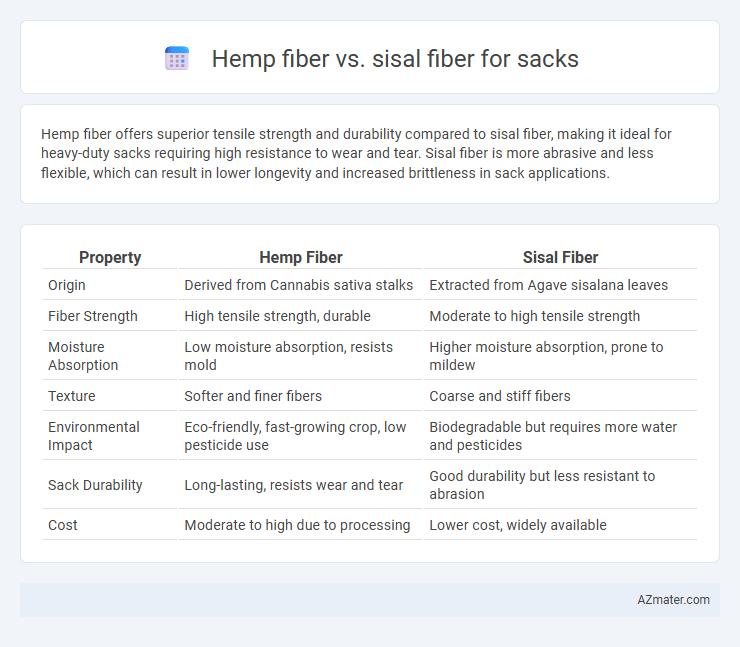Hemp fiber offers superior tensile strength and durability compared to sisal fiber, making it ideal for heavy-duty sacks requiring high resistance to wear and tear. Sisal fiber is more abrasive and less flexible, which can result in lower longevity and increased brittleness in sack applications.
Table of Comparison
| Property | Hemp Fiber | Sisal Fiber |
|---|---|---|
| Origin | Derived from Cannabis sativa stalks | Extracted from Agave sisalana leaves |
| Fiber Strength | High tensile strength, durable | Moderate to high tensile strength |
| Moisture Absorption | Low moisture absorption, resists mold | Higher moisture absorption, prone to mildew |
| Texture | Softer and finer fibers | Coarse and stiff fibers |
| Environmental Impact | Eco-friendly, fast-growing crop, low pesticide use | Biodegradable but requires more water and pesticides |
| Sack Durability | Long-lasting, resists wear and tear | Good durability but less resistant to abrasion |
| Cost | Moderate to high due to processing | Lower cost, widely available |
Introduction to Hemp and Sisal Fibers
Hemp fiber, derived from the stalks of the Cannabis sativa plant, is known for its high tensile strength, durability, and resistance to mold, making it a superior material for sacks used in heavy-duty applications. Sisal fiber, extracted from the leaves of the Agave sisalana plant, offers excellent coarse texture and flexibility, commonly used in packaging and agricultural sacks due to its natural bio-degradability and moisture-wicking properties. Both fibers are sustainable and eco-friendly options, with hemp providing greater longevity while sisal excels in affordability and ease of processing.
Historical Usage in Sack Production
Hemp fiber has been historically valued for sack production due to its exceptional durability and resistance to moisture, making it ideal for storing agricultural products and heavy goods since ancient times. Sisal fiber, derived from the Agave plant, gained prominence in the 19th century with its coarse texture and robust tensile strength, which suited regional markets in East Africa and South America. Both fibers played crucial roles in the evolution of sack manufacturing, with hemp favored in Europe and sisal dominating tropical regions for burlap and rope applications.
Physical Properties Comparison
Hemp fiber exhibits superior tensile strength, averaging around 550-900 MPa, compared to sisal fiber's 400-600 MPa, making hemp more durable for sack applications. Hemp fibers have a higher elongation at break of approximately 2-4%, providing better flexibility, whereas sisal's elongation ranges from 2-3%. Moisture absorption is lower in hemp fibers (8-12%) than sisal fibers (10-13%), contributing to enhanced resistance against environmental degradation in sack products.
Environmental Impact and Sustainability
Hemp fiber has a significantly lower environmental impact than sisal fiber due to its rapid growth rate and minimal need for pesticides or herbicides, making it highly sustainable for sack production. Hemp also enriches soil health through phytoremediation and requires less water, reducing its ecological footprint compared to water-intensive sisal cultivation. While sisal fiber is durable, hemp's biodegradability and carbon sequestration properties contribute to a more eco-friendly lifecycle in packaging applications.
Strength and Durability Analysis
Hemp fiber exhibits superior tensile strength and abrasion resistance compared to sisal fiber, making it highly suitable for heavy-duty sack applications. Its lignin content and long fiber length contribute to exceptional durability under high stress and repeated use. Sisal fiber, while cost-effective and biodegradable, generally offers lower strength and tends to degrade faster in moist or abrasive environments.
Cost-Effectiveness and Market Availability
Hemp fiber offers superior durability and biodegradability compared to sisal fiber, making it highly cost-effective for long-term sack use, despite a higher initial price. Sisal fiber boasts greater market availability due to widespread cultivation and established supply chains, reducing lead times and procurement costs for sack manufacturers. Balancing cost-effectiveness and accessibility, hemp is favored for premium sacks, while sisal is preferred in markets prioritizing affordability and immediate supply.
Processing and Manufacturing Differences
Hemp fiber undergoes a retting process that uses moisture to break down the pectin binding the fibers, resulting in longer, stronger strands ideal for durable sacks. Sisal fiber extraction involves decortication, mechanically scraping leaves to separate stiff fibers suited for coarse, abrasion-resistant sacks. Manufacturing hemp sacks requires finer spinning and weaving techniques to maximize its tensile strength, while sisal sacks benefit from simple weaving methods due to the fiber's natural rigidity and coarseness.
Applications in Modern Packaging
Hemp fiber offers superior tensile strength and biodegradability, making it ideal for durable and eco-friendly sacks in agricultural and industrial packaging. Sisal fiber provides excellent abrasion resistance and moisture absorption, suitable for packaging requiring rough handling and humidity control. Both fibers contribute to sustainable packaging solutions by reducing plastic use and enhancing recyclability.
Biodegradability and End-of-Life Considerations
Hemp fiber offers superior biodegradability compared to sisal fiber, breaking down more rapidly in natural environments, which reduces long-term environmental impact for sack production. Sisal fiber, while durable, has a slower decomposition rate due to its lignin content, making waste management more challenging. Both fibers are compostable, but hemp sacks provide enhanced sustainability benefits during end-of-life scenarios by minimizing landfill persistence and facilitating soil regeneration.
Conclusion: Choosing the Best Fiber for Sacks
Hemp fiber offers superior strength, durability, and natural resistance to moisture and pests, making it ideal for heavy-duty sacks that require long-lasting performance. Sisal fiber is more affordable and provides good abrasion resistance but lacks the overall toughness and environmental benefits of hemp. For sacks demanding maximum durability and eco-friendliness, hemp fiber is the optimal choice.

Infographic: Hemp fiber vs Sisal fiber for Sack
 azmater.com
azmater.com